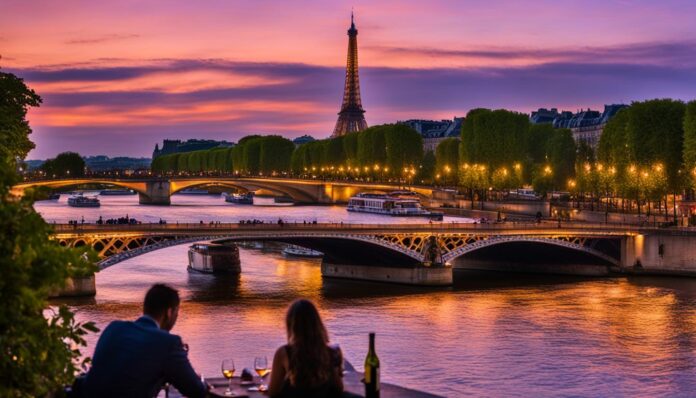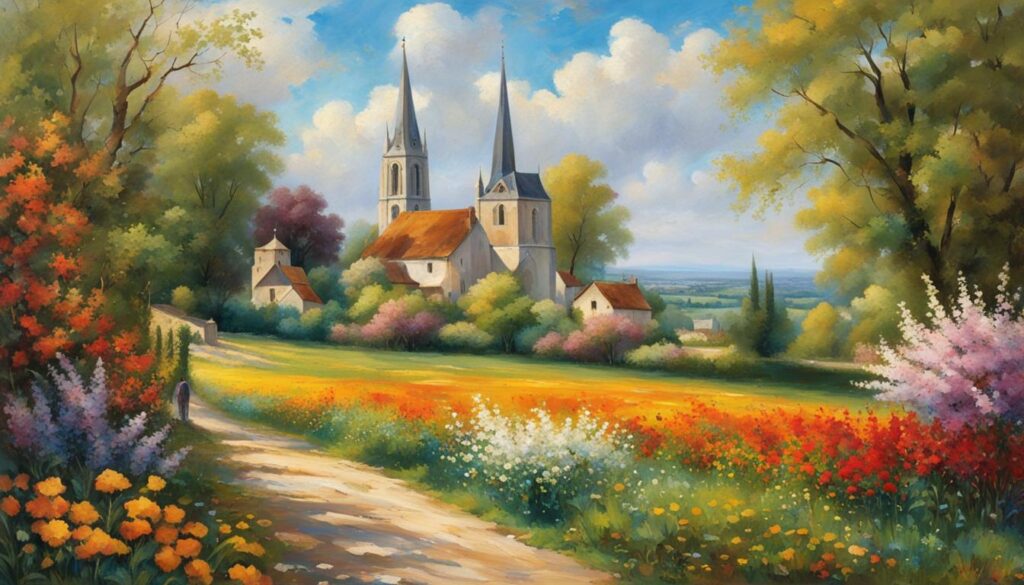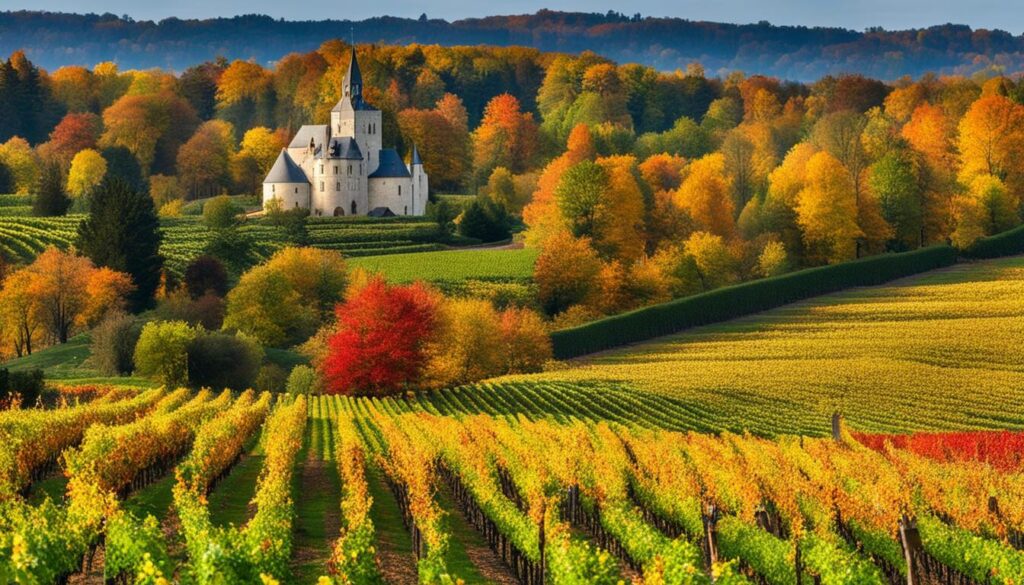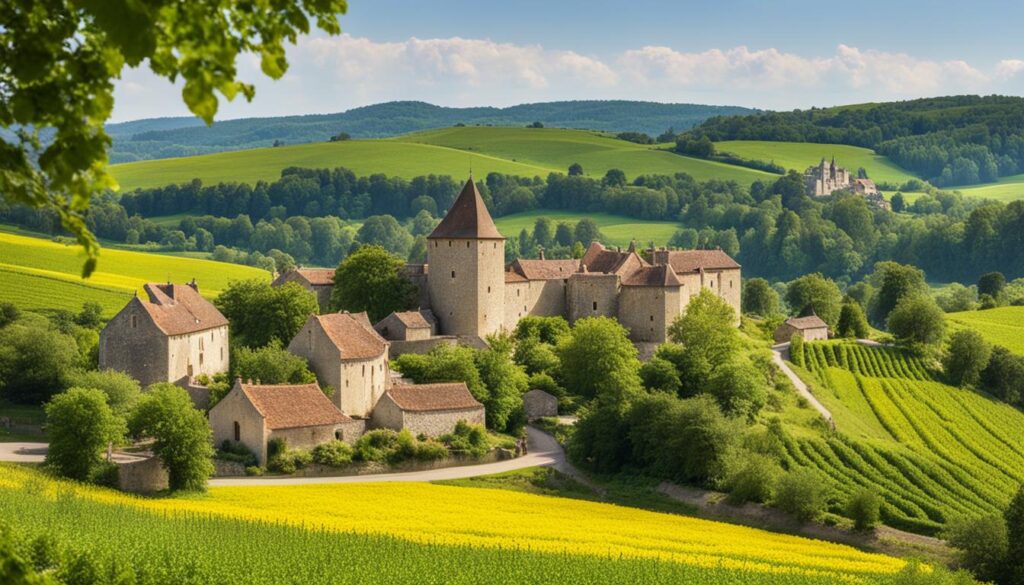Planning a trip to France? One of the first things to consider is the best time of year to visit. Whether you’re planning to explore the bustling cities, relax on the beaches, or taste the world-renowned cuisine, the season you choose to travel can greatly impact your overall experience.
When deciding on the ideal time to visit France, there are several factors to consider. These include weather conditions, tourist crowds, seasonal attractions, and personal preferences and interests. By taking these factors into account, you can determine the best seasons to visit France and make the most of your trip.
Read on to discover France travel tips, as we explore the different seasons and conditions to help you find the ideal time to visit the country. This article will guide you in answering the question: What is the best time of year to visit France?
Understanding France’s Climate and Weather Patterns
Before you plan your trip to France, it’s important to understand the climate and weather patterns in different regions throughout the year. France has a temperate climate, with mild winters and warm summers. However, there are regional variations that can greatly affect your travel experience.
In general, the best seasons to visit France are in the spring (March – May) and fall (September – November), when the weather is mild and the tourist crowds are lower. Summer (June – August) is the peak tourist season, with warmer temperatures and longer daylight hours, but also high prices and overcrowded attractions. Winter (December – February) can be cold and rainy, but also less expensive and less crowded.
| Season | Climate | Pros | Cons |
|---|---|---|---|
| Spring | Mild temperatures, occasional rain | Blooming landscapes, lower tourist crowds, seasonal produce, Easter celebrations | May can be unpredictable, some attractions may be closed or have limited hours |
| Summer | Warm temperatures, occasional heat waves | Long daylight hours, outdoor activities, beach vacations, cultural events | Peak tourist season, high prices, overcrowded attractions, occasional thunderstorms |
| Fall | Mild temperatures, occasional rain | Vibrant autumn foliage, harvest festivals, lower tourist crowds, food and wine events | Some attractions may be closed or have limited hours, occasional rain and wind |
| Winter | Cold temperatures, occasional snow | Christmas markets, skiing opportunities, fewer tourists, lower prices | Short daylight hours, some attractions may be closed or have limited hours, cold and rainy weather |
As you can see from the table, each season in France has its own advantages and challenges. Depending on your personal preferences and interests, you may find that one season is more suitable for your trip than others. Additionally, keep in mind that the climate and weather in France can vary greatly depending on the region you are visiting. Coastal areas tend to be more temperate, while inland areas can have more extreme temperatures.
Overall, the ideal time to visit France may depend on a variety of factors, including the type of activities you want to do, your budget, and your tolerance for crowds and weather conditions. By understanding the climate and weather patterns in France and considering your personal preferences, you can make an informed decision on the best time to plan your trip.
Exploring the Spring Season (March – May)
If you’re looking for the optimal months to visit France, spring can be a great choice. The tourist crowds are still relatively low, and the weather is mild and pleasant, making it an ideal time for outdoor activities and exploring the country’s natural beauty.
Weather and Temperatures
During spring, the weather in France is comfortable, with temperatures ranging between 50-65°F (10-18°C) on average. While it might rain occasionally, it’s usually not heavy or long-lasting, and you can expect plenty of sunny days to enjoy. Keep in mind that the weather can vary depending on the region you’re visiting, with the south being generally warmer and drier than the north.
Blooming Landscapes and Seasonal Festivals
One of the highlights of visiting France in the spring is the blooming landscapes, with colorful flowers and trees adding to the already charming scenery. You can witness this stunning display of nature in many parks and gardens, such as the famous Jardin des Plantes in Paris or the Jardin Exotique de Monaco. Additionally, this season is host to several seasonal festivals, including the Cannes Film Festival and the Nice Carnival, which are worth exploring if you’re in the area.
Outdoor Activities
Spring is an excellent time for outdoor activities in France, and there are plenty of options to choose from. You can go hiking in the French Alps or Pyrenees, take a leisurely bike ride in the countryside, or enjoy a picnic in one of the many parks and gardens. The mild temperatures make it an ideal season for exploring the country’s beautiful landscapes and historical landmarks without the sweltering heat of summer.
Recommended Destinations
| Destination | Reasons to Visit |
|---|---|
| Paris | Visit the blooming gardens, museums, and famous landmarks without the summer crowds. |
| Provence | Experience the stunning lavender fields in full bloom and sample delicious springtime cuisine. |
| Normandy | Explore the charming coastal towns and enjoy the beautiful countryside without the tourist crowds. |
Overall, visiting France in the spring can be an excellent choice if you’re looking for mild weather, beautiful landscapes, and fewer tourist crowds. Whether you’re exploring the vibrant cities of Paris and Nice or wandering through the picturesque countryside of Provence and Normandy, you’re sure to have a memorable experience.
Embracing the Summer Season (June – August)
Summer is the peak tourist season in France, and understandably so. The warm weather and long daylight hours make it an attractive time to visit, especially if you’re planning to enjoy outdoor activities, such as hiking, swimming, or sunbathing. Additionally, the summer season offers the perfect opportunity to explore the French Riviera and the Mediterranean coast, known for luxurious beaches and stunning landscapes.
However, the downside of visiting France during the summer is the high number of tourists, which means that popular attractions and destinations will be crowded, and prices for accommodations and transportation will be higher. If you’re planning to visit France during the summer season, it’s recommended to book your accommodations and tickets well in advance and to be prepared for long queues and waits at popular sites.
Optimal Months to Visit France in Summer
The optimal months to visit France in summer are June and September. While July and August are the busiest months, June and September offer milder temperatures and fewer crowds, making them ideal for a peaceful and relaxed vacation.
Seasonal Recommendations for Visiting France in Summer
Summer in France offers a plethora of activities and attractions to choose from. Here are some seasonal recommendations:
- Beach vacations in the French Riviera and the Mediterranean coast
- Attending music festivals and outdoor concerts
- Visiting national parks and nature reserves
- Exploring outdoor markets and food festivals
- Attending Bastille Day celebrations on July 14th
Table: Average Temperature in France in Summer
| Month | Temperature (°F) |
|---|---|
| June | 60 – 73 |
| July | 64 – 79 |
| August | 63 – 78 |
| September | 58 – 72 |
Overall, the summer season in France has its pros and cons, and the optimal time to visit depends on your preferences and interests. Whether you choose to visit during the peak season or opt for a quieter period, France has something to offer to every traveler.
Enjoying the Fall Season (September – November)
If you are looking for fewer crowds and pleasant weather, fall may be the optimal time to visit France. The temperatures start to cool down, and the changing colors of the leaves create a picturesque backdrop for exploring the country.
The peak tourist season is over, so you can avoid crowds and enjoy the attractions and activities at a more leisurely pace. The fall also marks the beginning of the harvest season, which means that you can indulge in the country’s delicious seasonal produce and wines.
Seasonal Recommendations for Visiting France
The fall season is ideal for outdoor activities such as hiking, biking, and exploring the French countryside. You can also attend local festivals and events such as the grape harvest and wine festivals, Halloween celebrations, and the Chestnut Festival in the Ardèche region.
If you are a foodie, fall is the perfect time to sample the seasonal dishes such as mushroom-based dishes, game meats, and squash soups. You can also taste the freshly pressed apple cider and sample the famous Beaujolais Nouveau.
Regional Weather Variations
| Regions | Average Temperature (°F) | Weather Conditions |
|---|---|---|
| Paris | 57-64 | Mild temperatures with occasional rainfall |
| Provence | 60-69 | Warm temperatures with occasional rain showers |
| Normandy | 53-60 | Cool temperatures with light rain |
As you can see from the table, the weather in France varies by region during the fall, so it’s important to check the weather forecast for your planned destinations.
The fall foliage in France is one of the most spectacular displays in the world, with vibrant colors of red, orange, and yellow adding to the country’s beauty. The image above captures the essence of fall in France.
Optimal Months to Visit France
The best months to visit France in the fall are September, October, and November. The temperatures are mild, and the crowds have thinned out, making it easier to navigate through popular tourist attractions.
It’s important to note that some tourist sites may have shorter hours or be closed during the fall season, so it’s important to check availability and hours of operation ahead of time.
Whether you’re looking for outdoor activities, food, wine, or cultural experiences, fall offers something for everyone in France.
Experiencing the Winter Season (December – February)
If you prefer snowy landscapes and winter sports, then the winter season (December-February) could be the ideal time to visit France. Although the weather can be cold, it offers a unique and magical experience that cannot be found in other seasons.
In December, France transforms into a winter wonderland with charming Christmas markets, festive decorations, and twinkling lights. You can indulge in mulled wine, hot chocolate, and other delicious treats while shopping for gifts or souvenirs. The city of Strasbourg hosts one of the oldest Christmas markets in Europe, offering a magical atmosphere with over 300 chalets.
Another winter attraction is skiing in the French Alps, which is a popular activity from December to February. France boasts some of the best ski resorts in the world, including Chamonix, Val d’Isère, and Courchevel. You can enjoy breathtaking views, fresh powder, and a range of slopes suitable for all levels. Keep in mind that the prices can be higher during peak season, so it’s recommended to book in advance.
If you’re visiting France in February, you can experience the carnival season, which is celebrated in many cities with parades, costumes, and parties. The most famous carnival takes place in Nice, known as the Carnival of Nice, which attracts thousands of visitors each year. The carnival features spectacular floats, music, and fireworks, making it a memorable event for all ages.
While the winter season may not be the most popular time for tourists, it offers a unique experience for those who love the snow and winter activities. Keep in mind that some attractions and activities may have limited opening hours or be closed during this season, so it’s recommended to check in advance.
Festivals and Events Throughout the Year
France is a country rich in culture and history, and there are many festivals and events throughout the year that showcase this. Whether you’re interested in music, food, art, or sports, there is something for everyone. To make the most out of your trip to France, consider attending some of these events:
- Bastille Day: On July 14th, France celebrates its National Day with parades, fireworks, and parties all over the country. The biggest celebration is in Paris, where you can watch the military parade on the Champs-Élysées and enjoy the fireworks display over the Eiffel Tower.
- Tour de France: The world’s most famous bicycle race takes place over three weeks in July, with riders covering more than 2,000 miles across the French countryside. The route changes every year, but there are always stages in the Alps and Pyrenees mountains, providing breathtaking views for spectators.
- Festival d’Avignon: This world-renowned performing arts festival takes place every July in the city of Avignon. It features theater, dance, music, and film from around the world, with hundreds of shows to choose from.
- Montmartre Grape Harvest Festival: In October, the charming Montmartre neighborhood of Paris celebrates the grape harvest with parades, music, and of course, wine tastings. The highlight of the festival is the grape-picking competition, where teams race to harvest the most grapes in the shortest amount of time.
- Christmas Markets: From late November until Christmas Eve, cities and towns all over France host Christmas markets, where you can shop for handmade gifts, ornaments, and traditional French treats like mulled wine and gingerbread. Some of the most famous markets are in Strasbourg, Colmar, and Lille.
Keep in mind that these events can affect tourist crowds and prices, so if you’re planning to attend, be sure to book your accommodations and travel well in advance.
Considering Tourist Crowds
If you prefer to avoid crowds while traveling, it’s important to consider the tourist traffic in France at different times of the year. The peak season for tourism in France is typically from June to August, when schools are out and the weather is warm and sunny. During this time, you can expect large crowds at popular attractions and longer wait times for restaurants and accommodations.
If you’re looking for a more relaxed vacation, consider visiting France during the shoulder seasons of spring and fall. In the spring, you can enjoy mild temperatures and blooming landscapes without the crowds that come with summer tourism. In the fall, you can experience the vibrant autumn foliage and harvest festivals without the summer heat.
If you plan to visit France during the busy summer season, be sure to book your accommodations and attractions in advance to avoid disappointment. Consider visiting popular destinations early in the morning or later in the evening to avoid the busiest times of day.
Off-Season Travel
If you’re looking for an even quieter travel experience, consider visiting France during the off-season months of November through March. While the weather may be cooler and some attractions may be closed, you can enjoy lower prices on accommodations and flights. Keep in mind that some regions may be less accessible during the winter months, such as ski resorts in the Alps.
Tourist Crowds by Region
| Region | Peak Tourist Season | Off-Season |
|---|---|---|
| Paris | June-August | November-February |
| Provence | June-September | November-April |
| French Riviera | June-August | November-April |
| Normandy | June-September | November-April |
As you can see, the peak tourist season varies by region in France. If you’re visiting a popular destination like Paris or the French Riviera, expect larger crowds during the summer months. However, if you’re exploring more off-the-beaten-path areas like Normandy or the Loire Valley, you may find fewer crowds even during the busy summer season.
Seasonal Attractions and Activities
France offers a wide range of attractions and activities that vary depending on the season. You can plan your trip according to your interests and preferences to make the most of your time in France. Here are some of the seasonal attractions and activities to consider:
Spring (March – May)
During the spring season, the weather is mild, and flowers begin to bloom, creating picturesque landscapes. It’s an ideal time to visit gardens such as the Tuileries Garden in Paris or the Monet’s Garden in Giverny. Spring is also an excellent time to visit the French Riviera and enjoy the beaches before the summer crowds arrive.
Summer (June – August)
Summer in France is all about outdoor activities. The long daylight hours and warm weather provide the perfect opportunity to explore the countryside, go hiking and cycling, and experience the French way of life. France has over 200 beaches to choose from, so summer is a great time to sunbathe, swim, and relax by the coast. You can also attend music festivals, open-air concerts, and cultural events that take place throughout the country.
Fall (September – November)
The fall season is when the landscape of France transforms into a beautiful mosaic of red, orange, and gold. The mild weather is perfect for outdoor activities such as hiking, cycling, and wine tasting in the vineyards. Fall is also the season for gastronomic festivals that celebrate the harvest, such as the Oyster Festival in Brittany and the Chestnut Festival in Corsica.
Winter (December – February)
Winter in France is all about the holiday season, skiing, and exploring the Christmas markets. The ski resorts in the French Alps are world-renowned, with slopes suitable for beginners and experts alike. The Christmas markets in Strasbourg, Colmar, and Lille are famous for their traditional crafts, festive music, and delicious food. Winter is also an excellent time to visit museums and art galleries as there are fewer tourists during this season.
As you plan your trip to France, consider the different seasonal attractions and activities to help you make the most out of your visit.
Budget Considerations
When planning your trip to France, it is essential to consider the impact of seasons on travel costs. Accommodation rates, flight prices, and availability of deals or discounts vary significantly throughout the year.
If you are traveling on a budget, the low season, which is typically November to March, might be the best time to visit France. During this period, travel and accommodation costs are lower than other times of the year. Additionally, many attractions and restaurants offer off-season discounts, making it an ideal time to enjoy France without breaking the bank.
However, if you prefer warmer weather or want to experience specific seasonal events, such as the lavender fields in Provence or the Christmas markets in Paris, you may need to budget accordingly for higher travel and accommodation expenses.
It is crucial to book your accommodation and transportation early to take advantage of early bird discounts. You can also save on food and drinks by choosing local eateries and markets over expensive tourist hotspots.
Overall, carefully considering your budget and timing your visit accordingly can help you have an enjoyable and affordable trip to France.
Personal Preferences and Interests
When deciding on the best time to visit France, it’s important to consider your personal preferences and interests. Whether you’re looking for outdoor activities, cultural events, or specific attractions, there are plenty of options to suit your tastes.
If you’re a fan of skiing and winter sports, then visiting France during the winter season (December – February) is ideal. You can hit the slopes in popular destinations like Chamonix and Val Thorens while enjoying the festive atmosphere of Christmas markets and other winter events.
On the other hand, if you’re interested in exploring France’s beautiful gardens and countryside, then spring (March – May) and fall (September – November) might be more to your liking. The mild temperatures and blooming landscapes of spring make it the perfect time for outdoor activities like hiking and cycling, while the colorful autumn foliage and harvest festivals of fall create a cozy and romantic ambiance.
If you’re a foodie, then consider visiting France during summer (June – August), when you can indulge in the country’s famous cuisine at numerous outdoor markets, festivals, and events. Summer is also an excellent time for beach vacations, with many coastal towns and resorts offering a range of activities such as swimming, boating, and sunbathing.
Ultimately, the best time to visit France depends on what you want to experience and enjoy. By considering your personal preferences and interests, you can plan a trip that’s tailor-made to your tastes and expectations.
Conclusion
Deciding on the best time of year to visit France depends on various factors, such as weather preferences, seasonal attractions, tourist crowds, and personal interests. By considering these factors, you can plan a vacation to France that aligns with your preferences and maximizes your enjoyment.
If you’re looking for optimal weather conditions, the best time to visit France is during the summer months of June to August. However, if you prefer to avoid the peak tourist season, visiting during the shoulder season of spring or fall can provide milder temperatures, fewer crowds, and seasonal festivals.
Winter in France can be cold and snowy, but it also offers unique opportunities for skiing, Christmas markets, and cultural events. And while budgets can fluctuate depending on the season, planning ahead and being flexible can help you find affordable options for your trip.
Ultimately, the best time to visit France is when it aligns with your personal preferences and interests. So whether you’re a history buff, a foodie, or an adventurer, there’s a season in France that’s perfect for your ideal vacation timing.
Now that you have a better understanding of the different factors to consider when planning your France vacation timing, you can start envisioning your perfect trip to this beautiful country. Bon voyage!
















































